In this lesson, using automatically created motion as the basis, you’ll animate a biped walking with a rolling, springy step.
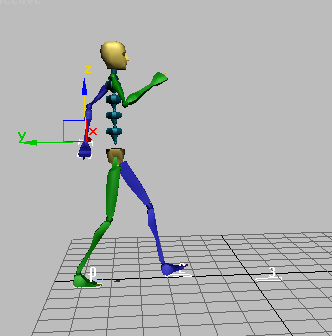
The automatic footsteps generate a starting point for you. You’ll then change the automatic walk into something more expressive and distinctive. This sophisticated yet simple approach results in a natural-looking motion that you can create quickly.
Set up the lesson:
In this file, a biped is standing near the origin.
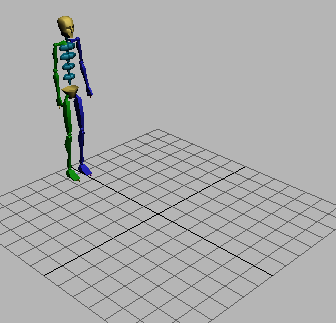
Biped near origin of grid
A white box outlines the selected body part.
 Open
the Motion panel.
Open
the Motion panel. The Biped controls are displayed.
Next you’ll turn on Footstep Mode. If Figure Mode was on, it turns off automatically.
Create multiple footsteps:
 On the
Motion panel, in the Biped rollout, turn on Footstep Mode.
On the
Motion panel, in the Biped rollout, turn on Footstep Mode.
 The
Footstep mode button turns yellow, and the Footstep Creation and
Footstep Operations rollouts are displayed.
The
Footstep mode button turns yellow, and the Footstep Creation and
Footstep Operations rollouts are displayed.
 In the
Footstep Creation rollout, click Create Multiple Footsteps.
In the
Footstep Creation rollout, click Create Multiple Footsteps.The Create Multiple Footsteps: Walk dialog is displayed. Here you see many parameters for creating multiple footsteps. You’ll only change the number of footsteps, leaving the other defaults as they are.
Footprints are displayed in white in the viewport. These are inactive footsteps. They do not yet control any animation for the biped. If you click the Play Animation button, the biped won't move.
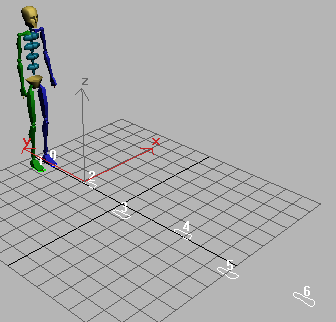
Inactive footsteps
 In the
Footstep Operations rollout, click Create Keys For Inactive Footsteps.
In the
Footstep Operations rollout, click Create Keys For Inactive Footsteps.The footsteps are activated. Animation keys are created for the biped.
The biped walks.
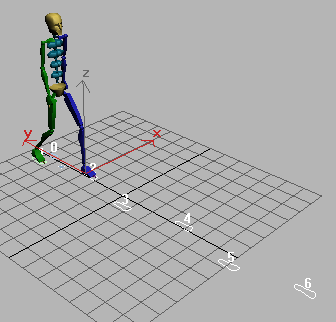
The biped takes a step.
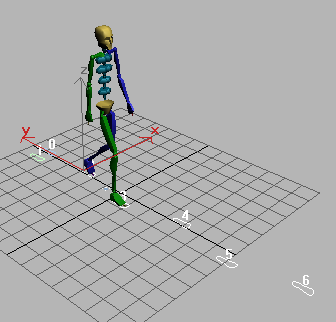
The biped takes another step.
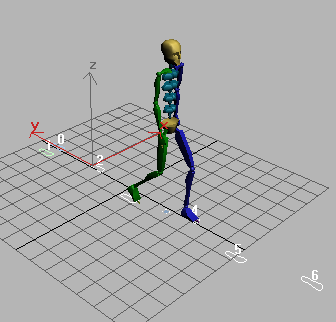
The biped keeps on walking.
Notice that the first footstep is numbered 0, and the last footstep is numbered 7.
 In the
Track Selection Rollout, click the Body Horizontal button. This
selects the horizontal position track for the center of mass (COM)
object.
In the
Track Selection Rollout, click the Body Horizontal button. This
selects the horizontal position track for the center of mass (COM)
object.The track bar displays keys for the length of the animation.

Body Horizontal keys
 In the
Track Selection rollout, click the Body Vertical button. This turns
off Body Horizontal.
In the
Track Selection rollout, click the Body Vertical button. This turns
off Body Horizontal.Keys are visible at the same frames on the track bar.

Body Vertical keys
The biped walks, but without much character.
In the following procedures, you'll begin individualizing the motion by adjusting the keys for the Body Horizontal, Vertical, and Rotation tracks. You'll exaggerate the rotation of the center of mass to create a more energetic walk.
Adjust body rotation keys:
 In the
Perspective viewport, use Arc Rotate to shift the view so that the
biped is walking toward you. Then move the time slider to frame
0.
In the
Perspective viewport, use Arc Rotate to shift the view so that the
biped is walking toward you. Then move the time slider to frame
0.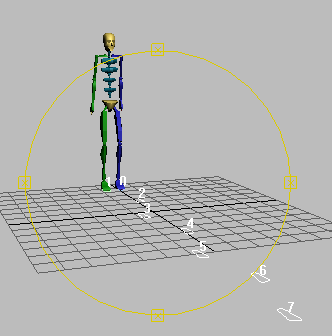
 Be sure
a part of the biped is still selected. In the Track Selection rollout,
click the Body Rotation button.
Be sure
a part of the biped is still selected. In the Track Selection rollout,
click the Body Rotation button.
The Transform gizmo displays for rotation. The track bar displays the rotation keys.

 On the 3ds Max status
bar, click the Key Mode button to turn on Key mode.
On the 3ds Max status
bar, click the Key Mode button to turn on Key mode. Key mode lets you use Previous and Next Key buttons to jump between keyframes for the selected object. You can also use the < and > keys on the keyboard to move between keyframes without clicking the mouse.
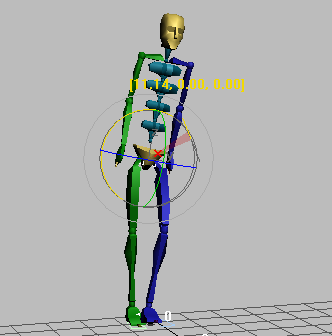
Rotation of the center of mass object about the X axis
 On the
Motion panel, open the Key Info rollout and click the Set Key button.
On the
Motion panel, open the Key Info rollout and click the Set Key button.When you set the key, the biped will shift position slightly. In the viewport, you can see that the blue foot is no longer crossing the green.
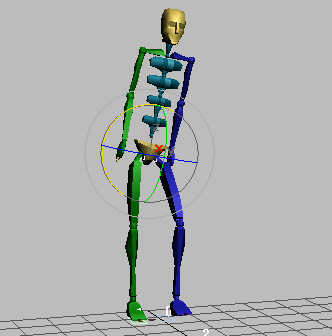
Biped foot snaps away from the other foot.
What is happening is that the foot, calf, and thigh bones are being controlled by the footstep gizmos. The footsteps represent a pair of keys with IK Blend set to 1 and the Join To Prev IK key turned on. When you set the key, these settings force the foot, calf, and leg bones back into the correct path for walking.
 Click
Next Key three times to move to frame 40.
Click
Next Key three times to move to frame 40.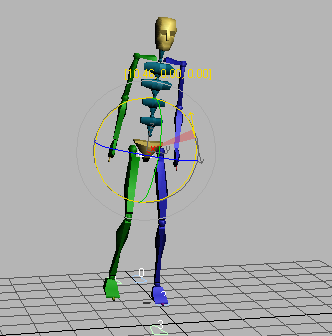
Negative rotation with blue foot in contact with the ground
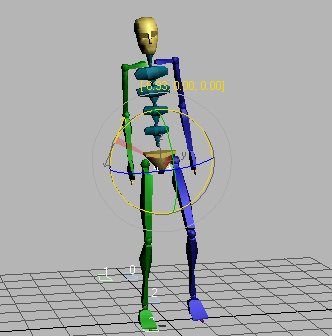
Positive rotation at frame 54
When you are done, play the animation and notice the increased hip swings that result from rotating the center of mass back and forth.
 On the
Biped rollout, click Save File and save the file as mywalk.bip.
On the
Biped rollout, click Save File and save the file as mywalk.bip.If you load the newly saved mywalk.bip file into a scene containing a skinned character, the character will swing its hips according to the instructions you saved in this file. Play the animation to determine if you need to adjust it. For instance, Dr. X (from the quick start tutorial) has huge feet, which may need to be moved further apart so they don't pass through the legs accidentally.
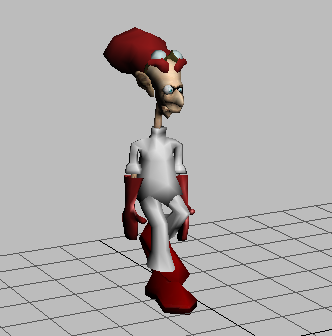
Dr. X character with distinctive walk
Add spring to the step:
To load a BIP file, create or select a biped. On the Motion panel > Biped rollout, click Load File and open the file. This transfers all the movement information in the file to the biped.
 On the
Track Selection rollout, click the Body Vertical button.
On the
Track Selection rollout, click the Body Vertical button.This selects the vertical position track for the center of mass object.
 Turn
on Key Mode, if it isn't already on.
Turn
on Key Mode, if it isn't already on.The knees bend because the feet are controlled by the footsteps.
 After
making a change at a frame, click the Set Key button on the Key
Info rollout.
After
making a change at a frame, click the Set Key button on the Key
Info rollout.This sets a key for the change you've made in the viewport; otherwise, the change is discarded.
The biped walks with newfound bounce.
 On the
Biped rollout, click Save File. Name the file mywalk2.bip.
On the
Biped rollout, click Save File. Name the file mywalk2.bip.Add arm and hand motions:
Arm and hand motions are an integral part of an individual’s gait. In the following sequence, you'll customize the arm motion by moving the hands and rotating the arms.
You previously created keyframes using the Set Key button; however, for this technique, you'll use Auto Key instead.
 Turn
on the Auto Key button.
Turn
on the Auto Key button.When the green foot is extended, the blue arm swings forward. When the blue foot swings out, the green arm swings forward. See if you can find the frame at which the hand extends the farthest forward.
The track bar displays the keys for the hand.
There is a key in track bar at that frame for the hand object.
Using the Transform gizmo, move the hand approximately 10 units upward on the Z axis.
By moving the hand, you've also rotated the two arm bones. The keys for the hand and arm bones are stored on a single track.
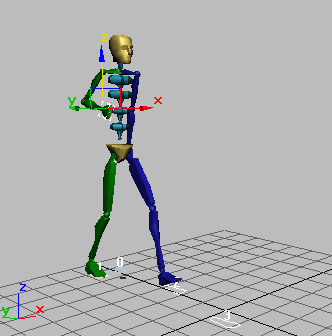
The hand moved upward
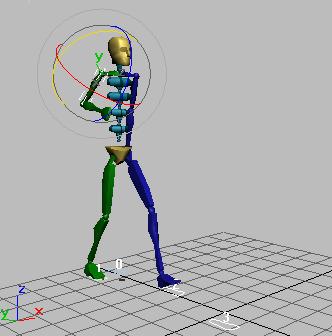
The upper arm rotated around the Z axis
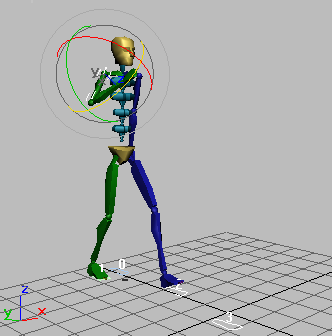
The hand rotated close to the chest
You can position the arm using forward kinematics (the rotation of the parent objects) or inverse kinematics, using position transform on the end of the chain: in this case, the position of the wrist. You can also rotate the hands.
 Use
Arc Rotate to adjust the view angle so you can see the angle of
the other arm behind the biped.
Use
Arc Rotate to adjust the view angle so you can see the angle of
the other arm behind the biped.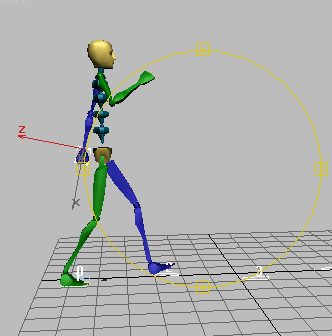
View of the arm behind the biped

Save it as mywalk3.bip.

Dr. X with spring in his step
Add head motions:
You can edit the head motion to make the biped’s walk look more natural. In this procedure, you'll add head rotations to accentuate the COM rotation.
 Turn
on Auto Key, if it isn’t on already.
Turn
on Auto Key, if it isn’t on already. Turn
on Key mode, if it isn’t on already.
Turn
on Key mode, if it isn’t on already. In the
Perspective viewport, select the biped's head using Rotate on the 3ds Max main
toolbar.
In the
Perspective viewport, select the biped's head using Rotate on the 3ds Max main
toolbar.
The head rotated downward
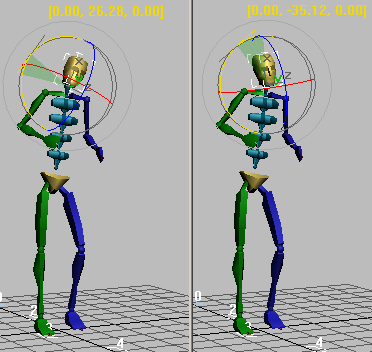
Rotate the head to follow the movement, or rotate the head to oppose the shoulders.
Natural head motion is smooth, so the orientations should change gradually from one key to the next.
You can now save your work as mywalk4.bip. You can check your file against head_rotate_with.bip and head_rotate_against.bip.
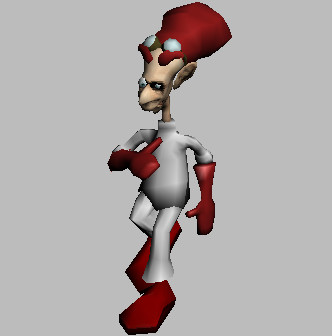
Dr. X's distinctive walk with head rotation